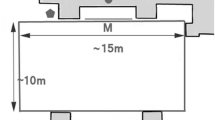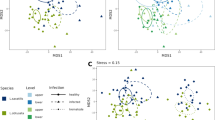Summary
Reduced glutathione evokes a feeding response, the tentacle-ball formation inHydra japonica. This response consists of at least 5 components (R1–R5). We raised 6 monoclonal antibodies (mAbs), each of which depressed a specific subset of these components, and we also examined the immunocytochemical localization of antigens with these mAbs at light microscopic level. The 2 mAbs that depressed R2 and R4 bound to the cnidocils of the desmoneme and the stenotele nematocytes; the 3 mAbs that depressed R5 bound to the apical surface adjacent to the cnidocils of the nematocytes; and the 2 mAbs that depressed R1 and R3 bound to the apical spot structures of unidentified cells in the ectoderm.
Together with the specificity of the action of the mAbs on the behavioral response, the correspondence between the effects on the response and the structures visualized with these mAbs suggests that these structures include components of the receptor-effector system relevant to chemoreception.
Similar content being viewed by others
Abbreviations
- FITC :
-
fluorescein isothiocyanate
- GSM :
-
S-methylglutathione
- HRP :
-
horseradish peroxidase
- mAb :
-
monoclonal antibody
- PBS :
-
phosphate-buffered saline
- R1–R5 :
-
components of hydra feeding response
References
Bode HR, David CN (1978) Regulation of a multipotent stem cell, the interstitial cells ofHydra. Progr Biophys Mol Biol 33:189–206
Bode HR, Smith GS, Bode PM (1983) Masurement of the numbers of nematoblasts, nematocytes, and nematocysts. In: Lenhoff HM (ed)Hydra: research methods, Chapt 23. Plenum, New York, pp 169–182
Chapman DM (1974) Cnidarian histology. In: Muscatine L, Lenhoff HM (eds) Coelenterate biology: reviews and new perspectives. Academic Press, New York, pp 1–92
Dunne JF, Javois LC, Huang LW, Bode HR (1985) A subset of cells in the nerve net ofHydra oligactis defined by a monoclonal antibody: its arrangement and development. Dev Biol 109:41–53
Ewer RF (1947) On the functions and mode of action of the nematocytes ofHydra. Proc Zool Soc Lond 117:305–376
Hanai K (1981) A new quantitative analysis of the feeding response inHydra japonica: stimulatory effects of amino acids in addition to reduced glutathione. J Comp Physiol 144:503–508
Hanai K, Kato H, Matsuhashi S, Morita H, Raines EW, Ross R (1987a) Platelet proteins including platelet-derived growth factor specifically depress a subset of the multiple components of the response elicited by glutathione inHydra. J Cell Biol 104:1675–1681
Hanai K, Sakaguchi M, Matsuhashi S, Hori K, Morita H (1987b) Monoclonal antibodies to multiple glutathione receptors mediating the feeding response ofHydra. Ann NY Acad Sci 510:335–338
Hanai K, Oomura Y, Kai Y, Nishikawa K, Morita H, Shimizu N, Plata-Salaman C-R (1989) Central action of acidic fibroblast growth factor in the feeding regulation. Am J Physiol 256:R217-R223
Hawkes R (1986) The dot immunobinding assay. In: Langon J, Vunakis HV (eds) Methods in enzymology, vol 121. Academic Press, New York, pp 484–491
Hufnagel LA, Kass-Simon G, Lyon MK (1985) Functional organization of battery cell complex in tentacles ofHydra attenuata. J Morphol 184:323–341
Katsuki Y, Hashimoto T, Yanagisawa K (1970) The lateral-line organ of shark as a chemoreceptor. Adv Biophys 1:1–51
Kitajima M (1985) The galactose-binding membrane proteins ofHydra as putative glutathione receptors: a behavioral and biochemical study. Ph. D Thesis, Kyushu University
Koizumi O, Kijima H (1980) Specific S-methylglutathione incorporation into a nematocyst-rich fraction ofHydra. Biochem Biophys Acta 629:338–348
Lancet D (1986) Vertebrate olfactory reception. Ann Rev Neurosci 9:329–355
Lenhoff HM (1961) Activation of the feeding reflex inHydra littoralis. I. Role played by reduced glutathione and quantitative assay of the feeding reflex. J Gen Physiol 45:331–344
Lenhoff HM (1968) Chemical perspectives on the feeding response, digestion, and nutrition of selected coelenterates. In: Florkin M, Scheer BT (eds) Chemical zoology, vol II, Chapt 3. Academic Press, New York, pp 157–221
Lentz TL, Barrnett RJ (1962) The effect of enzyme substrates and pharmacological agents on nematocyst discharge. J Exp Zool 149:33–39
Loomis WF (1955) Glutathione control of the specific feeding reactions ofHydra. Ann NY Acad Sci 62:211–227
Matsuhashi S, Arai Y, Watanabe T, Hori K (1989) Preparation of monoclonal antibodies against nuclear antigens in a DNA affinity purified protein fraction from chick embryo extract. Jpn J Exp Med 59:139–147
Schreier M, Konler G, Hengartner H, Berek C, Trucco M, Forni L, Staehelin T, Stocker J, Takacs B (1980) Hybridoma techniques. EMBO, SKMB Course, Basel
Slautterback DB (1967) The cnidoblast-musculoepithelial cell complex in the tentacles ofHydra. Z Zellforsch Mikrosk Anat 79:296–318
Stoline MR (1981) The status of multiple comparisons — simultaneous estimation of all pairwise comparisons in one-way ANOVA designs. Am Statistic 35:134–141
Udenfried S, Stein S, Bohlen P, Dairman W, Leimgruber W, Weigele M (1972) Fluorescamine: a reagent for assay of amino acids, peptides, proteins, and primary amines in the picomole range. Science 178:871–872
Venturini G (1987) TheHydra GSH receptor. Pharmacological and radioligand binding studies. Comp Biochem Physiol 87C:321–324
Wood RL, Novak PL (1982) The anchoring of nematocysts and nematocytes in the tentacles ofHydra. J Ultrastruc Res 81:104–116
Yelton DE, Diammond BA, Kwan S-P, Schaff MD (1978) Fusion of mouse myeloma and spleen cells. Curr Top Microbiol Immunol 81:1–7
Author information
Authors and Affiliations
Rights and permissions
About this article
Cite this article
Sakaguchi, M., Hanai, K., Ohta, K. et al. Monoclonal antibodies that depress a specific subset of multiple components of the glutathione-induced response ofHydra . J Comp Physiol A 168, 409–416 (1991). https://doi.org/10.1007/BF00199601
Accepted:
Issue Date:
DOI: https://doi.org/10.1007/BF00199601




